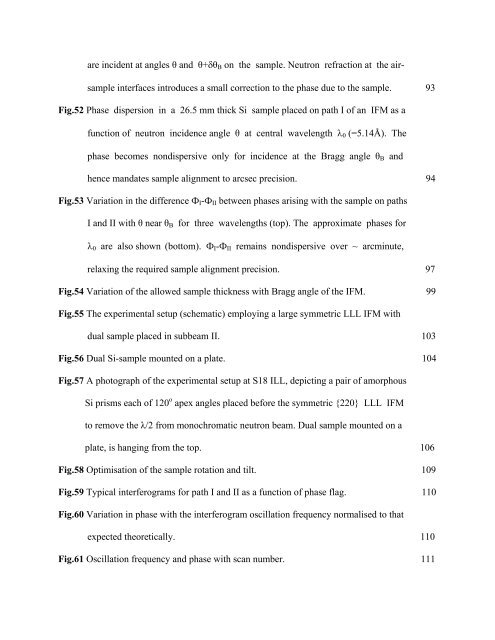PHYS01200804001 Sohrab Abbas - Homi Bhabha National Institute
PHYS01200804001 Sohrab Abbas - Homi Bhabha National Institute
PHYS01200804001 Sohrab Abbas - Homi Bhabha National Institute
Create successful ePaper yourself
Turn your PDF publications into a flip-book with our unique Google optimized e-Paper software.
are incident at angles θ and θ+δθ B on the sample. Neutron refraction at the airsample<br />
interfaces introduces a small correction to the phase due to the sample. 93<br />
Fig.52 Phase dispersion in a 26.5 mm thick Si sample placed on path I of an IFM as a<br />
function of neutron incidence angle θ at central wavelength λ 0 (=5.14Å). The<br />
phase becomes nondispersive only for incidence at the Bragg angle θ B and<br />
hence mandates sample alignment to arcsec precision. 94<br />
Fig.53 Variation in the difference Ф I -Ф II between phases arising with the sample on paths<br />
I and II with θ near θ B for three wavelengths (top). The approximate phases for<br />
λ 0 are also shown (bottom). Ф I -Ф II remains nondispersive over ~ arcminute,<br />
relaxing the required sample alignment precision. 97<br />
Fig.54 Variation of the allowed sample thickness with Bragg angle of the IFM. 99<br />
Fig.55 The experimental setup (schematic) employing a large symmetric LLL IFM with<br />
dual sample placed in subbeam II. 103<br />
Fig.56 Dual Si-sample mounted on a plate. 104<br />
Fig.57 A photograph of the experimental setup at S18 ILL, depicting a pair of amorphous<br />
Si prisms each of 120 o apex angles placed before the symmetric {220} LLL IFM<br />
to remove the λ/2 from monochromatic neutron beam. Dual sample mounted on a<br />
plate, is hanging from the top. 106<br />
Fig.58 Optimisation of the sample rotation and tilt. 109<br />
Fig.59 Typical interferograms for path I and II as a function of phase flag. 110<br />
Fig.60 Variation in phase with the interferogram oscillation frequency normalised to that<br />
expected theoretically. 110<br />
Fig.61 Oscillation frequency and phase with scan number. 111
















